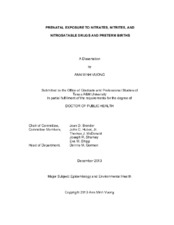| dc.description.abstract | Nitrosatable drugs react with nitrite in the stomach to form N-nitroso compounds, observed in animal models to result in adverse pregnancy outcomes such as birth defects and reduced fetal weight. Previous studies examining prenatal exposure to medications classified as nitrosatable have observed an increased risk of preterm delivery. Vitamin C is a known nitrosation inhibitor.
Using data from mothers (controls) of babies without major birth defects from the National Birth Defects Prevention Study, we examined the relation between preterm births and: 1) prenatal nitrosatable drug usage; 2) dietary intake of nitrates/nitrites; 3) joint exposures to nitrosatable drugs and nitrate/nitrite intake; and 4) nitrosatable drugs and vitamin C intake among 496 case-mothers of preterm infants and 5398 control-mothers who delivered full term babies from 1997-2005.
An increased risk of preterm births was observed with secondary amine exposure during the second (adjusted hazard ratio (aHR) 1.37, [95% confidence interval (CI) 1.05, 1.79]) and third (aHR 1.34, [95% CI 1.02, 1.76]) trimester. A protective effect was detected with high levels of plant nitrites (aHR 0.72, [95% CI 0.53, 0.97]). Exposure to secondary amines and high levels of nitrite were associated with preterm births, having an increased risk with first (aHR 1.84, [95% CI 1.14, 2.98]), second (aHR 1.89, [95% CI 1.17, 3.07]), and third (aHR 2.00, [95% CI 1.22, 3.29]) trimester exposure. Lower risk of moderately preterm births was observed with second trimester amide exposure in conjunction with higher levels of dietary vitamin C (aHR 1.14, [95% CI 0.66, 1.98]) compared to <85 mg/day (aHR 2.08, [95% CI 1.25, 3.47]).
Prenatal exposure to nitrosatable drugs during the second and third trimester, particularly secondary amines, might increase risk of preterm delivery. In addition, nitrosatable drugs, especially secondary and tertiary amines, and higher levels of dietary nitrite (including animal, plant, and total) may increase risk of preterm births. However, dietary vitamin C intake ≥85 mg/day may attenuate the association between nitrosatable drug use during the second trimester and preterm and moderately preterm births. In this study population, daily vitamin C supplementation did not appear to confer the same benefits. | en |


